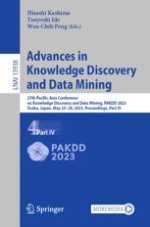2023 | Book
Advances in Knowledge Discovery and Data Mining
27th Pacific-Asia Conference on Knowledge Discovery and Data Mining, PAKDD 2023, Osaka, Japan, May 25–28, 2023, Proceedings, Part IV
Editors: Hisashi Kashima, Tsuyoshi Ide, Wen-Chih Peng
Publisher: Springer Nature Switzerland
Book Series : Lecture Notes in Computer Science
